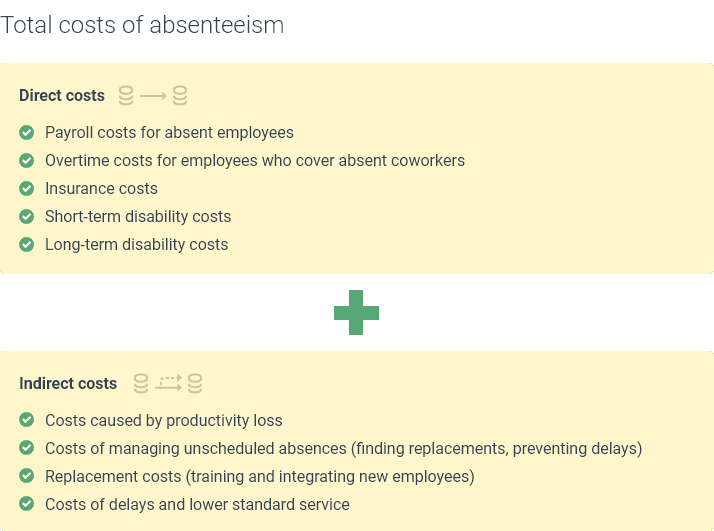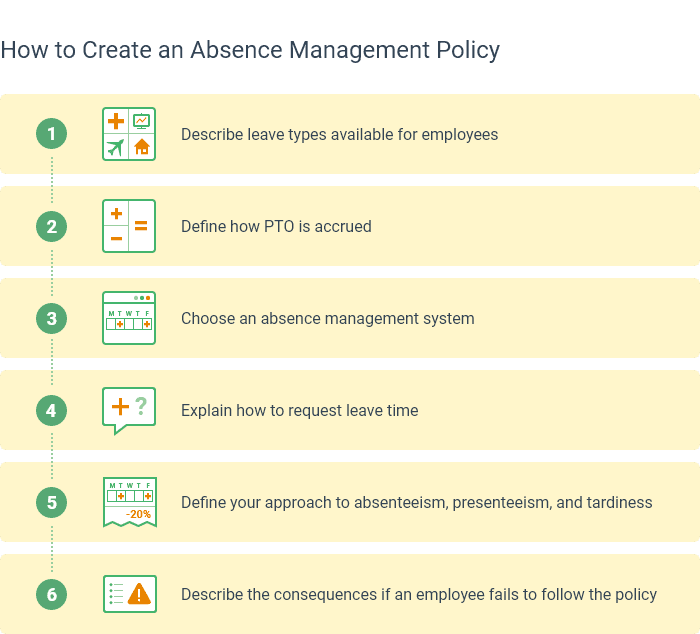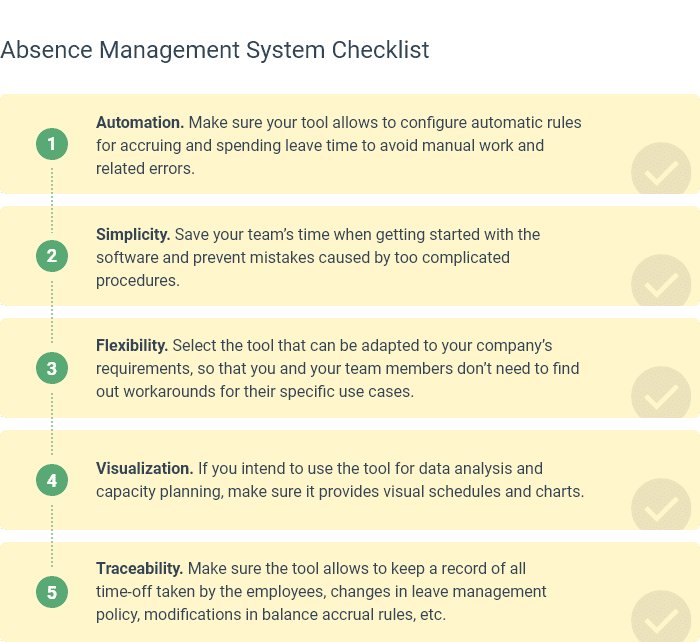In any workplace, employee absences are inevitable. Whether due to illness, family emergencies, or personal reasons, absences can disrupt workflow and productivity.
Effective absence management helps maintain operational continuity, supports employee well-being, and ensures fair treatment of all staff members. However, developing an absence management policy from scratch or revising an old one to meet today’s trends is often a challenge, as there are many aspects to take into account.
- How detailed should it be?
- What is it targeted to?
- How should it be connected to the company’s goals and vision?
In this blog post, we’ll explore the key components of effective absence management and offer actionable guidance on how businesses can implement strategies to handle absences proactively.
What Is Absence Management in HR?
Basically, absence management is the process of proactively managing and addressing employee absences in a way that minimizes disruption to the workplace, supports employee well-being, and ensures fair treatment of all staff members.
Effective absence management is important for HR departments for several reasons:
1. Operational continuity. By managing absences effectively, HR can ensure that there are adequate staffing levels to maintain business operations and productivity.
2. Cost control. Addressing absenteeism proactively can help reduce costs associated with lost productivity, overtime expenses, and temporary staffing.
3. Employee well-being. Supporting employees through effective absence management demonstrates a commitment to their well-being and helps create a positive work environment.
4. Legal compliance. Having clear absence policies and managing absences fairly can help HR departments comply with relevant labor laws and regulations.
5. Employee engagement. By promoting open communication and providing support for employees, HR can improve employee engagement and morale within the organization.
In course of time, absence management evolved from a set of measures for controlling and preventing absenteeism to complex procedures and actions that involve various aspects. Let’s take a closer look!
Leave management
Leave management, as it affects work environment, resource allocation and workload planning, requires a thorough approach. It includes requesting vacation, approving or rejecting the requests, and calculating resulting leave balances.
It’s not a really common case today when employees are allowed to book their vacations for any days they want, without coordinating this with management and colleagues. However, this sometimes happens in small businesses and startups that haven’t developed their absence policies yet.
The results are disastrous: employees who are blocked from booking leaves for most desired days of the year are dissatisfied, managers cannot plan work properly, and the overall work environment is undermined by the leave management system setup that invites conflicts. That is why two things are vital: developing a detailed written leave policy and implementing an approval procedure.
Another aspect of leave management is ensuring that employees take their earned leave and don’t accumulate it. Multiple studies conducted in different parts of the world show that untaken leaves cost a fortune to the companies, and not only due to compensation for unused leave time. Stress, fatigue, and burnout affect productivity dramatically – not to mention an increased risk of accidents at work.
Preventing absenteeism
Absenteeism, understood as being absent from the workplace without a valid reason, has been the crucial point of absence management for centuries: absenteeism was considered the worst enemy of productive work. Today, while it still creates problems for planning, performance and work environment, the understanding of its crucial role and its effects is different.
One of the key points of preventing absenteeism is reducing its costs. According to research, direct and indirect costs of absenteeism result in billions of dollars that companies lose each year, so companies invest considerable effort into keeping it to the minimum.

Fighting presenteeism
Managers and business owners who fought absenteeism in the past never considered the negative effects of its antagonist, presenteeism. However, its costs for businesses are greater than the costs of absenteeism – and the worst part is that they are mostly unseen.
It’s a well-known fact that presenteeism is fostered by measures taken to defeat unplanned absences. Employees turn up for work when they shouldn’t in fear of disciplinary measures for unscheduled absence at the workplace, or because they don’t want to let their team down, or due to lack of understanding what is a valid reason for absence.

What’s important here: presenteeism is not just about turning up for work while being sick. It’s also about such circumstances as family issues, high-stress levels, or even emergencies. An efficient absence management policy should clearly define these circumstances to prevent any misunderstandings and false expectations.
Managing tardiness and schedule changes
For some positions, punctuality is crucial, for some it’s not. Anyway, knowing when your coworkers are available is always essential for an efficient work process. This is especially true for employees with flexible schedules whose work hours only overlap for half a day.
In some teams and environments, it’s acceptable to ignore this aspect, but advanced absence management policies cover this too. In many cases, absence regulations include requirements and procedures for informing coworkers when you’re running late, leaving early, or are absent for a period longer than your lunch break.
Absence Management Policy
As we already mentioned, absence management effects are visible in HR, work management, planning, forecasting, and resource allocation. Taking into account its importance, companies tend to develop detailed policies that regulate every aspect of employees’ absence at the workplace. A written document is reasonable – even for small companies with 3-5 employees.
Below, we listed some key points for creating an absence management policy – you can use them as a checklist.
-
Define your approach to absenteeism, presenteeism, and tardiness
First of all, describe what actions should be qualified as absenteeism, presenteeism, tardiness, chronic tardiness, etc. – depending on your company’s requirements to the staff. Be clear about what is acceptable and what is not: this is a common thing for unscheduled absences and tardiness, but often gets overlooked in regards to presenteeism.
- Establish clear absence policies
Outline the procedures for reporting absences, acceptable reasons for time off, and the consequences of violating the policy. Set reasonable expectations and create a framework for managing absences consistently. - Implement an absence tracking system
By maintaining detailed records of absences, including reasons and dates, businesses can identify trends and address potential issues proactively. So, you need to specify where the employees log their absences and where the information on past, current and future absences is stored. It can be a spreadsheet, an HR software solution, or a special absence management tool that you chose for your team. -
Describe how the absence tracking system works
After you’ve set up the system for tracking absences, make sure that your employees understand how it works and how they are expected to use it. The best way is describing this in the absence management policy document. List leave types that are used in your company, approval procedure, define how leave balances are accrued, and what leave types affect them.
- Train managers and supervisors
Equip them with the tools and resources they need to manage absences, such as templates for documenting absences and conducting return-to-work interviews, will ensure consistent application of absence management policies. -
Define your actions
Specify what preventive, disciplinary and rewarding measures are used in your company in regards to employees’ absence at the workplace. Again, if you’re fighting against presenteeism, it’s reasonable to point out here that it is an unwelcome practice.
- Offer support for employees
Promote work-life balance and provide resources for personal and health-related issues to reduce the likelihood of extended absences. It can be flexible work arrangements, access to employee assistance programs (EAPs), and wellness initiatives. - Monitor and evaluate absence management strategies
Regularly review your absence management policy and procedures to ensure they remain effective and up-to-date. Collect feedback from employees on their experience with the absence management process and make adjustments as needed will help businesses continuously improve their absence management strategies.

Absence Management Methods
As for methods used in absence management, there are plenty of them, and mostly they are combined in companies’ absence management policies. Which of them are a reasonable choice for a specific company, depends on the industry, employees’ positions, and overall approach to absences.
Below, we’ve specified the most common ones that you’ll most likely need when developing your absence policy and related procedures.
-
Absence and attendance tracking
It’s barely possible to overestimate the importance of keeping everything recorded: planning for future work, forecasting team’s capacity, estimating current performance, and preventing or solving misunderstandings related to leaves and leave balances require a detailed log of past, present and upcoming absences on the team.
However, absence tracking is not only about work planning and creating a healthy work environment. Its other positive effects are understanding employees’ work-life balance and detecting trends related to unscheduled absences.
-
Preventive measures against unplanned absences
Unplanned absences involve higher costs that planned ones, and businesses tend to implement various preventive actions against them. Besides disciplinary measures, they can include self-service absence management systems where employees can inform their managers and colleagues about absences caused by short-term health issues and emergencies.
-
Schedule management
This method is used to manage tardiness and handle its effects. It includes various aspects from shift planning to managing teams with flexible schedules. Again, self-service systems can be here of help, as they allow inform coworkers when an employee is running late or leaving early.
-
Incentives for good attendance
An absence management method based on positive reinforcement – not really common, but applicable in different fields. Specific incentives can depend on the field, company’s resources and office culture. This method is definitely worth trying to complement disciplinary measures.
-
Return-to-work interviews
Designed to detect whether the employee is ready for resuming their work, return-to-work interviews can be also used for figuring out persisting problems and ways to help employees handle the problems that prevent them from being present at work and staying engaged.
Absence management strategies
Strategies in absence management are usually connected to the company’s vision and long-term goals. However, merely practical, tactical goals can also define an absence management strategy. Here’s the list of possible goals, ideas and targets that can influence strategic approach to absence management.
- Trust and loyalty: different absence-related perks fuel employees’ loyalty, as free time is one of the most valuable resources for many of us, and increases job satisfaction.
- Productivity: maintaining a healthy work-life balance positively influences productivity, creativity, and performance of individuals and teams.
- Reducing hidden costs: as we already mentioned above, absenteeism and presenteeism cost billions to companies, so taking measures against them means reducing their direct and indirect costs.
- Changing/ influencing corporate culture: preventing absence micromanagement and treating employees like adults creates a comfortable work environment and a healthy office culture.
- Health promotion: preventing health problems by mindfully managing attendance helps avoid major health-related issues in the long-term perspective.
- Flexibility: promoting flexible schedules and remote work helps people get more organized and use their time more wisely.
Absence Management Best Practices
Today’s trend in absence management policies is moving from the “consumerist” approach of the past years to being more personal. It derives from the understanding that making employees feel like cogs in a machine, not real people with their goals and problems, has become an obsolete and rather harmful approach that creates uncomfortable environments, negatively affects work-related relationships, and causes fatigue and burnout.
Among current best practices in communication around absence and attendance, and relationships with employees, we’d highlight the following:
- Finding a personal approach to people’s problems;
- Treating employees like adults;
- Supporting people who need help;
- Proactively preventing health and burnout problems.
In implementation of absence management procedures, the key point of the best practices is being efficient and saving time. Special tools used by large and small teams bring following benefits to employees and managers:
- Keeping absence management time expenses to the minimum;
- Providing a clear procedure for requesting and approving time off from work;
- Increasing transparency in leave time and balances calculation.
Absence Management Systems
After you’ve configured your absence management policy, it has to be implemented properly. Prepare documents describing and clarifying the policy’s principles, and select an absence management tool that you’ll be using. Various tools can be used depending on your team’s needs, and here’s a list of absence management systems that may work for your business.
- Spreadsheets. Used mostly in small businesses and startups, they are familiar to any employee and don’t require additional investment. The drawback is that they need special configuration, require a lot of manual work when filling out leave requests and calculating the balances, and are difficult to use in a multiuser environment (just remember those “please close the Leave Schedule file” requests you need to send over to your coworkers all the time!).
- Timesheet tools. Many vendors offer timesheet software that allows recording both work time and absences. While it’s handy to keep this information in one place, these tools usually don’t offer the request and approval functionality and don’t allow to plan team availability for future dates.
- HR software. HR systems that allow logging time off are designed for keeping record of past absences and planning for future. However, it’s often a problem with them that a lot of miscellaneous information is kept in the system, and it’s easy for employees to get confused. So, a longer period is required for getting started with this type of absence management systems.
- Special absence management tools. As they are designed specifically for absence management, these tools are usually clear and easy to use. The drawback is the need to implement yet another tool, but many businesses still find it reasonable. Special tools ensure the compliance of absence management procedures with current trends and best practices by saving time and preventing errors.
What to look at when selecting an absence management solution for your team? As we said above, one of the most important absence management trends today is automating the procedure and saving employees’ and managers’ time. Here’s a checklist of what to take into account to configure your absence management procedure according to the best practices.

Summary
When developing an absence management policy, take into account your company’s long-term goals, specific features of your field, your team’s office culture, and current best practices. Make sure all your employees understand how absence is managed in the company, and allocate time for that in onboarding process for new employees. Be open to feedback, and improve the policy if you see room for increasing its efficiency.



